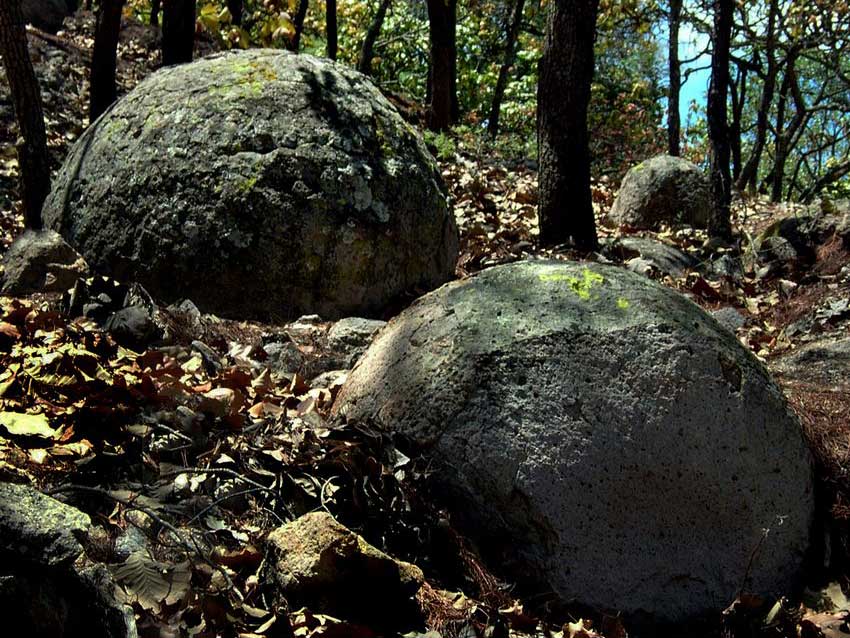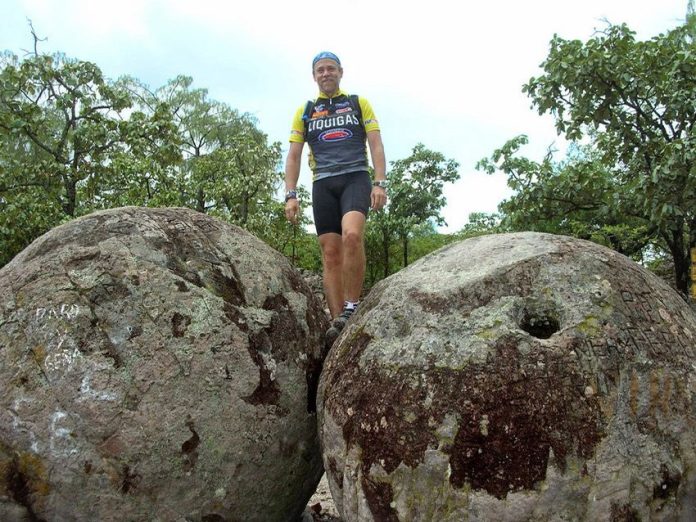Hidden away high in the Sierra de Ameca in the state of Jalisco, buried in a great bed of volcanic ash, lie dozens of naturally formed gigantic stone balls typically measuring from one to three meters in diameter.
Geologists call them megaspherulites, but to the local people in the nearest town, Ahualulco de Mercado, they are known as Las Piedras Bola.
According to historian Sergio Sigala, some of these balls were partially uncovered by unusually strong rains in the 1960s and were first noticed by a taxi driver named Miguel Hernández. One particular stone ball gave its name to the Piedra Bola silver mine located further downhill.
In 1969, Robert Gordon, retired director of this mine, sent photos of stone balls to ethnologist and archaeologist Matthew Williams Stirling who had described spheres beautifully worked by pre-Columbian natives of Costa Rica.
In short order, more and more stone balls were found in the nearby hills, and the word was out.
In this same year an article on these natural balls of rock appeared in the August National Geographic and the Piedras Bola gained international fame. The article refuted the idea that the giant balls may have been crafted by human or alien hands and put forth the first of several scientific theories on how they came to be.

United States Geological Survey geologist Robert L. Smith, who had led a National Geographic-Smithsonian expedition to the site in 1968, visualized the balls forming by crystallization of hot ash around nuclei of lava fragments, producing boulders of rhyolite.
In 2007 a study of the area was carried out by the University of Guadalajara (UdG), suggesting a variation of Smith’s hot-ash crystallization theory. As for the age of the balls, estimates range from 40 million years to less than ten million.
During the UdG study, 72 stone balls were located and measured and recommendations were made for development of this unique area in an ecologically friendly way. During the following two years, over 10 million pesos were spent by the Jalisco Secretariat of Culture to create infrastructure aimed at turning this remote site into one of western Mexico’s biggest tourist attractions.
For many years, the only way to reach the Piedras Bola was by walking along a six-kilometer-long footpath with a vertical difference of about 123 meters. During that long, hard hike you were likely to come across some of the 107 species of birds found in these rugged hills and perhaps spot the tracks of puma, mountain lions, wild boars or white-tailed deer — and you were frequently rewarded by dramatic views from several fine lookout points along the way.
In 2009, the path was widened, graded and turned into a drivable road. In addition, the developers had two zip-lines built along this route, one of them measuring 330 meters in length, as well as a long, wobbly 12-centimeter-wide suspension bridge which apparently could be crossed safely only by someone wearing a harness and clipped into an overhead cable.

The road takes you to an altitude of 1,908 meters where at last you find yourself on a path that winds its ways through dozens of these venerable spheres. Most of them are barely peeking out of the ground while others are fully exposed, typically ranging in size from one to three meters in diameter.
A few are cracked in half and rumor has it that a couple were actually blown to bits when they were first discovered, in the hope that something precious might be found at their center. Broken Bolas, however, clearly indicate there is nothing different or interesting to be found at their core. Geodes they are not.
It is possible though, that the Piedras Bola are actually extra-large versions of spherulites, balls of volcanic rock often found in and around obsidian flows. While spherulites may typically be no larger than a grain of rice, in some cases they may reach the size of a soccer ball. When you break them open, you usually find a radiating fibrous structure.
An examination of cracked Piedras Bola, however, shows no radiating or concentric textures indicative of crystal growth. “There’s no texture at all,” geologist Chris Lloyd told me. “It’s just massive lapilli tuff,” leaving the exact method of their formation still unclear.
The trail winds its way through some 72 Piedras Bola, according to the University of Guadalajara’s count. If you are willing to walk another kilometer, with an altitude gain of some 60 meters, you will come to Las Torrecillas, tall columns of volcanic tuff, each supporting a single stone ball.

As far as I can tell, these structures are formed by nothing more than rainfall washing away everything but the column underneath the rock.
In 2013, I offered to guide family members on a visit to the Piedras Bola. “Now there’s a road going there,” I told them. “Instead of hiking uphill for hours, panting and sweating, we can leisurely drive to the site in minutes!”
So off we went and everything looked great, although we remarked upon the narrowness of the road: “There isn’t room for two cars to pass. What happens if you meet someone going the other way?”
We passed the ziplines and the ultra-narrow suspension bridge, but found no one using them. A bit farther up we came to numerous parked cars and we soon discovered why they were there: suddenly what had been a useable dirt road turned into what looked like a minefield after the mines exploded, a collection of ruts that only a four-wheel-drive vehicle could negotiate.
We too had to turn around (no easy task on that narrow road with a 200-meter drop on one side) and find a place to park where space was at a premium. Why money had been poured into fancy ziplines instead of proper road construction we couldn’t fathom, but on this occasion, a Sunday, visitors to this extraordinary site numbered fewer than 20 people, suggesting you are never likely to find it crowded.
[soliloquy id="68681"]
Our mission that day was to search out the biggest natural ball we could find and measure it with a fiberglass tape to check on the accuracy of the previous survey. This turned out to be an easier task than I had envisioned because those few other people we found wandering around the place immediately offered to help us.
After much searching and measuring, the whole lot of us — who, by then, had become the best of friends — concluded that the very biggest ball we could find that day measured 2.9 meters in diameter.
After I bandied this number about, a local ornithologist told me “not all the Piedras Bola are up on that hill . . . for example, there are a dozen of them lying in a pasture that belongs to a relative of mine and you can drive to the place in just a few minutes.”
Sure enough, only 3.5 kilometers from Ahualulco, I found plenty of stone balls in that pasture and one which lay half buried in a nearby muddy stream looked to my now practiced eye much bigger than any I had seen “up on that hill.”
Unfortunately, the widest part of this particular ball lies underground, but we were able to measure the diameter of what protrudes from the earth and that turned out to be 3.9 meters.
I’m not sure the local authorities will be directing tourists to that little pasture in the near future, but if the possibly four-meter-wide megaspherulite we found does turn out to be the world’s largest, I hope this time they will forget about building any ziplines along the way.
• More information on the Great Stone Balls can be found in Outdoors in Western Mexico, Volume 2 and the driving/hiking route is shown on Wikiloc.
The writer has lived near Guadalajara, Jalisco, for more than 30 years and is the author of A Guide to West Mexico’s Guachimontones and Surrounding Area and co-author of Outdoors in Western Mexico. More of his writing can be found on his website.
